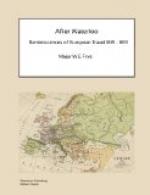The Piazza del Gran Duca is very striking to the eye of the northern traveller; the statues of the Gods in white marble in the open air would make him fancy himself in Athens in the olden time. The following statues in bronze and white marble are to be seen on this Piazza. In bronze are: a statue of Perseus by Cellini; Judith with the head of Holofernes by Donatello; David and Goliath; Samson. In white marble are the following beautiful statues: a group representing Hercules and Cacus; another representing a Roman carrying off a Sabine woman. The Hercules, who is in the act of strangling Cacus, rests on one leg. Nearly in the centre of the Piazza, opposite to the post office and in front of the Palazzo Vecchio, is the principal ornament of the Piazza, which consists of a group representing Neptune in his car or conch (or shell) drawn by sea-horses and accompanied by Tritons. The statue of Neptune is of colossal size, the whole group is in marble and the conch of Egyptian granite. This group forms a fountain. There is likewise on this Piazza an immense equestrian statue in bronze of Cosmo the First by John of Bologna. The Palazzo Vecchio is a large Gothic building by Arnulpho and has a very lofty square tower or campanile.
The Gallery of Florence being so close to my abode demanded next my attention. The building in which this invaluable Museum is preserved forms three sides of a parallelogram, two long ones and one short one, of which the side towards the south of the quai of the Arno is the short one.
On the north is an open space communicating with the Piazza del Gran Duca. The Gallery occupies the whole first floor of this vast building. The rez de chaussee is occupied, on the west side, by the bureaux of Government, and on the south and east sides by shopkeepers, in whose shops is always to be seen a brilliant display of merchandize. As there are arcades on the three sides of this parallelogram, they form the favorite meridian promenade of the belles and beaux of Florence, particularly on Sundays and holidays, after coming out of Church. I ascended the steps from a door on the east side of the building, to visit the Gallery.
The quantity and variety of objects of art, of the greatest value, baffle all description, and it would require months and years to attempt an analysis of all it contains. I shall therefore content myself with pointing out those objects which imprinted themselves the most forcibly on my imagination and recollection. In a chamber on the left hand of one wing of the Gallery stands the Venus de’ Medici, sent back last year from France. In the same chamber with her are the following statues: the extremely beautiful Apollino; the spotted Faun; the Remouleur or figure which is in the act of whetting a sickle. All these were in Paris, and are now restored to this Gallery. In this chamber two pictures struck me in particular: the one the Venus of Titian, a most voluptuous figure; the other a portrait of the mistress of Rafaello, called “La Fornarina,” from her being a baker’s daughter.




